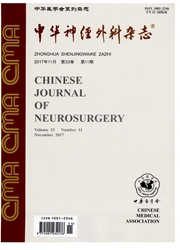

 中文摘要:
中文摘要:
目的探讨人神经干细胞(hNSCs)对脑肿瘤干细胞(BTSCs)的趋向性。方法利用神经球培养方法培养胶质母细胞瘤(GBM)来源的BTSCs。采用Transwell细胞迁移实验检测hNSCs对BTSCs的体外趋向性;利用立体定向注射的方法,建立裸鼠颅内AAV—EGFP—BTSCs移植瘤模型,将标记有红色荧光蛋白(RFP)的人源性NSCs(hNSCs)接种到移植瘤对侧脑组织,荧光显微镜观察hNSCs向移植瘤的迁移情况及在移植瘤体内的分布。结果GBM组织中可分离扩增到CDl33+和Nestin+的BTSCs细胞,BTSCs在体外以神经球的形式生长,将这些细胞接种到裸鼠颅内可形成新的胶质瘤。细胞迁移实验显示体外培养的hNSCs可向BTSCs定向迁移,裸鼠颅内移植瘤实验显示hNSCs可在颅内沿切线向BTSCs移植瘤定向迁移,并能穿透肿瘤组织,到达瘤组织中心区。结论外源hNSCs对BTSCs具有明确的体内外趋向性。这一特性可被用于干细胞为载体的基因治疗研究。
 英文摘要:
英文摘要:
Objective To clarify the capacity of selective migration of human neural stem cells (hNSCs) to brain tumor stem cells (BTSCs) derived from glioblastoma in vitro and vivo. Methods The BTSCs were cultured from GBM tissues by Neurosphere culture method and the tropism ability of hNSCs to BTSCs were investigated using in vitro transwell chamber cell migration assay and in vivo tumor tropism studies. Results The BTSCs could be obtained from human GBM tissues, and formed neuroshpheres after cultured 7 days in vitro, and were CD133 - positive and nestin -positive. Theses BTSCs could regenerate a GBM tumor in vivo when implanted intraventricularly. Cell migration assay showed that the BTSCs had the capacity to actively attract hNSCs. The fate of hNSCs in vivo could be visualized under confoeal fluorescence microscope. The hNSCs exhibited extensive tropism toward the site of the tumor and infiltrate tumor foei . Conclusions The BTSCs could be derived rapidly from GBM tissues by neurosphere method. The normal hNSCs possesse the capacity to migrate toward BTSCs in vitro and vivo. The tropism of hNSCs towards brain tumors may provide an additional tool for the treatment of brain cancer.
 同期刊论文项目
同期刊论文项目
 同项目期刊论文
同项目期刊论文
 期刊信息
期刊信息
